According to a report by Statista and eMarketer, online retail sales are projected to reach $6.51 trillion by 2023. That same report also says that ecommerce websites will claim around 22.3% of all retail sales.
So, if you weren’t planning on investing in your ecommerce strategy this year, you should. Here, we’ll talk about the different elements of a smart ecommerce strategy. You’ll get familiar with:
- Trends in product strategy
- Supply chain management in 2023
- SEO and online visibility
- Reputation management
- Influencer and affiliate marketing
- Big data analytics
- Local SEO
- Customer nurturing strategy
Not only that, we have included some sage advice and tips from industry experts on the emerging trends you can expect to encounter in 2023.
Data and search are pretty much the big topics I see everyone talking about. What I’ve noticed with a lot of people (clients and a lot of agencies) is that by not knowing what to do with their data, it’s costing the company a small fortune, not just loss of potential new revenue/customers but also lost revenue on acquiring data and not understanding what they should be doing with it.
Other experts who have shared their wisdom in this article include:
Without further delay, let’s jump into it!
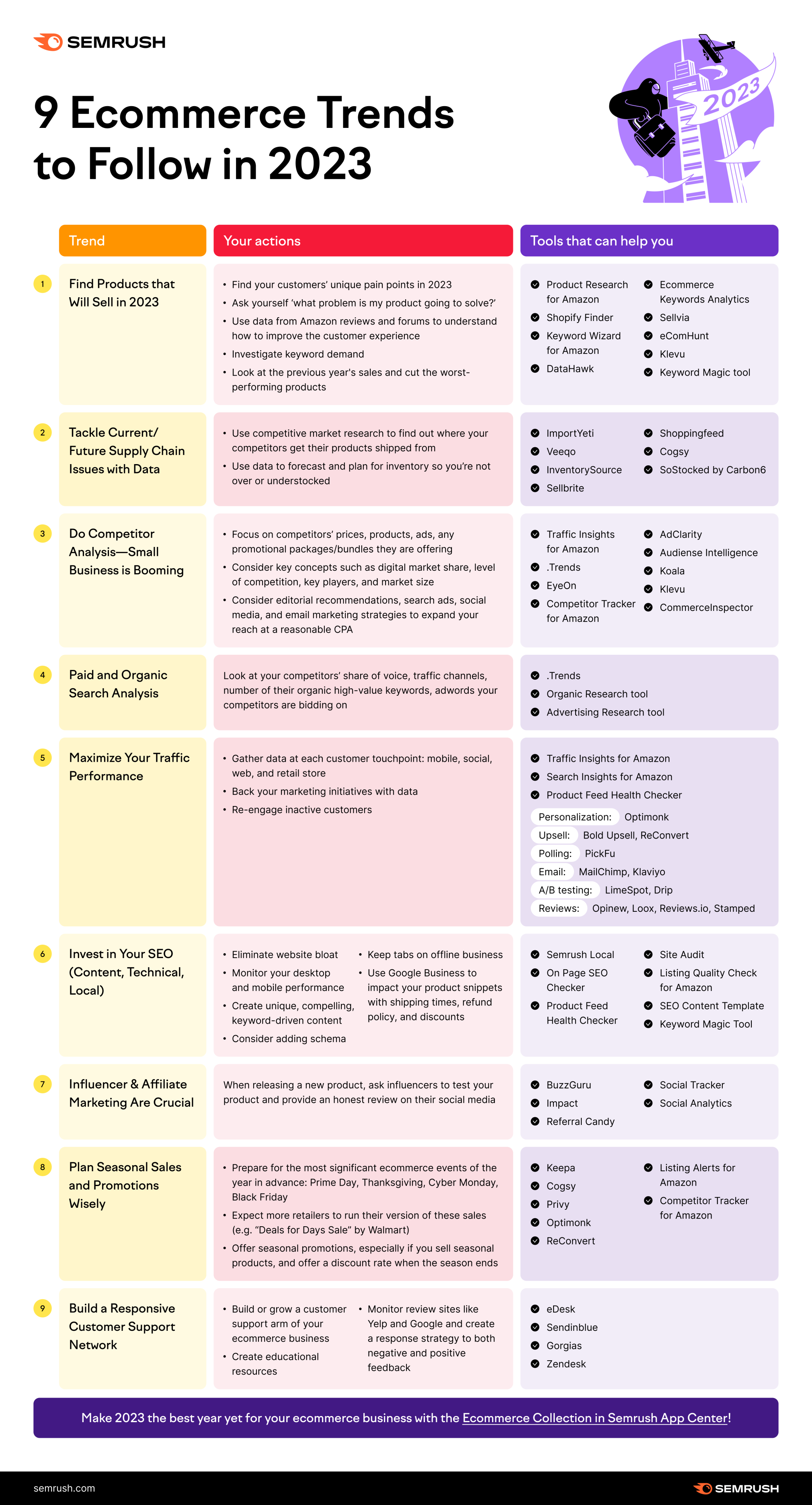
Find Products That Will Sell in 2023
Finding the right products to sell is key to success in ecommerce. You can no longer create commodity or ‘me too’ products and expect success. Instead ask yourself ‘what problem is my product going to solve’ and ‘why would someone buy my product’ as opposed to all the others out there. Use data from Amazon reviews and forums to understand how to make better products and improve the customer experience. That along with understanding keyword demand on Amazon will allow everything to flow more easily as you launch and market your product. [This will be especially popular in 2023] because ecommerce has gotten more competitive and old strategies I mentioned no longer work.
Arguably the first and most important thing you should focus on is what products to sell.
While inflation is expected to fall from 8.8% to 6.5% in 2023—meaning consumers will have more purchasing power in the next 12 months—you still need to be highly selective about which products you plan to offer in this economy.
You can take several approaches to fine-tune your product offerings:
- Look at the previous year’s sales, cut the lowest performing product, and invest that cashflow back into sourcing more products that have been selling well
- Think about a problem you have that a product could solve, and research to see if others have the same issue
- Consider what unique pain points your customers will be facing in 2023—COVID-19 restrictions, inflation, recession, and a digital-forward culture will all impact consumer buying decisions
- Do keyword research to determine what customers are searching for
Let’s flesh out that last bullet with an example. Keyword research offers a fantastic way to get a sense of what problems customers are facing and trying to solve in the new year.
One way to figure out what customers want is by looking at search engine results. Keyword Magic Tool gives you data on both exact and broad match keywords, meaning you can see what else people are searching for in addition to the keywords you have selected.
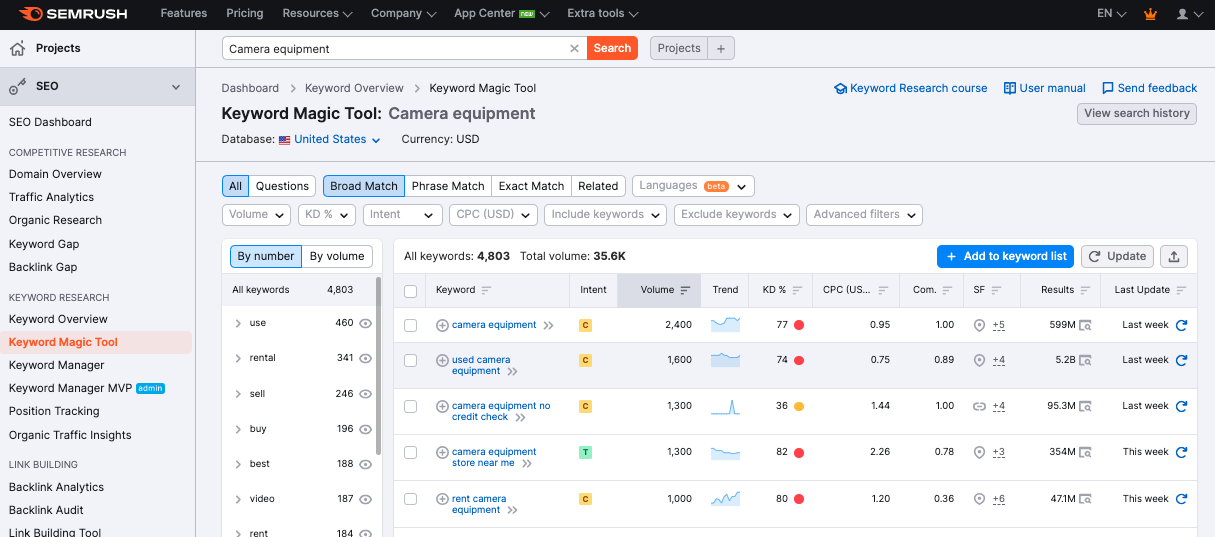
But even if you have a brilliant, keyword-focused product strategy lined up for 2023, you will still need to learn how to work the current global supply chain.
Tools that can help:
- Product Research for Amazon—Get fresh data on in-demand ecommerce products, find top-profit products using intuitive filters, and estimate your ROI with built-in calculators
- Shopify Finder—Get insights on 50+ million Shopify products and 100+ million AliExpress products that cover 40+ countries (AliExpress data is available with a Pro plan)
- Keyword Wizard for Amazon—Get access to a huge database of 200+ million keywords and smart filters, and find high-volume/low-competition terms to help you win in Amazon search
- Ecommerce Keywords Analytics—Learn the top-performing keywords for major retailers, find keywords that convert, and evaluate product potential
- DataHawk—Access fully customizable KPIs and dashboards that expand your ecommerce reporting and data management/workflows
- Sellvia—Gain access to a 250+ million audience of U.S.-based digital buyers; let Sellvia handle storage, delivery, and returns to the U.S.; and discover new business opportunities
- Ecomhunt—Get a curation of the best new products every day with detailed analytics on profits, engagement, links, ads, targeting, and price
- Klevu—Uncover shopper intent and help your products get discovered
Tackle Current/Future Supply Chain Issues with Data
In terms of next year, I think Supply Chain will be a major emphasis for most retailers. 2023 will mark the first year since COVID hit where we will not have a set of YOY sales data skewed by COVID. Retailers should have more accurate data to forecast and plan for inventory so they’re not running out or overly stocked of products.
Global shortages of items like children’s pain relievers, computer chips, garage doors, and even a beloved hot sauce have created a stressed consumer base.
A number of compounding factors caused these shortages, including the novel COVID-19 virus, unemployment, a reduction in raw materials, and global unrest.
Unfortunately, these issues are not projected to improve in 2023. But you don’t have to panic just yet.
Knowledge is power, and with the help of free apps like ImportYeti, you can use competitive market research to source suppliers and keep products on your shelves. Your inventory might not be as robust as it was pre-2020, but you don’t have to live in supply-chain limbo.
ImportYeti shows you over 70 million U.S. customs sea shipment records. This is invaluable data on where your competitors get their products shipped from.
Let’s say you run a video game ecommerce business. Your top competitor might be GameStop. If that’s the case, enter “GameStop” into ImportYeti to see what its inventory looks like and where it sources its products.
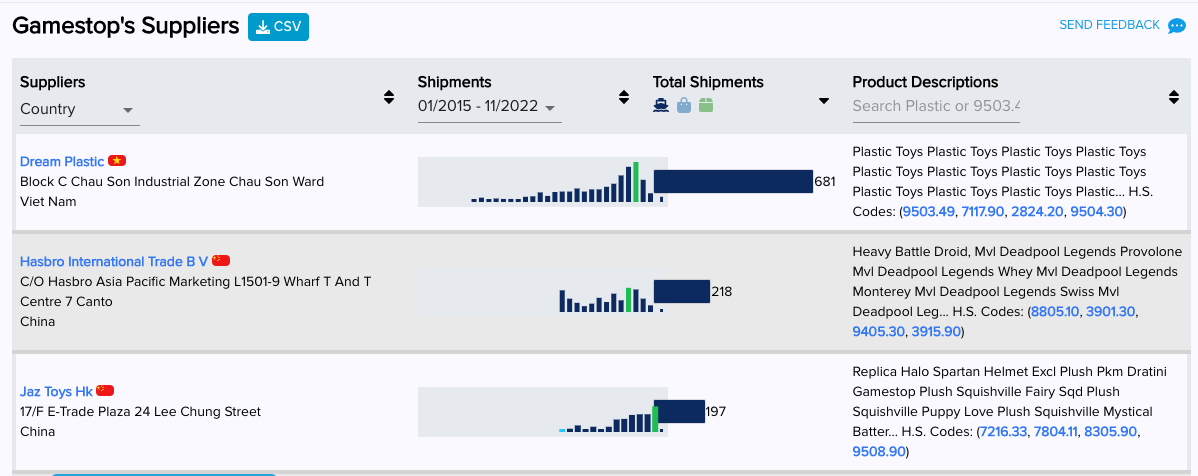
You can filter your results by the supplier’s country of origin, the date range of their shipments, the total number of shipments, and even the product descriptions (which also has a keyword search feature so you can really narrow down your research).
Not only that, ImportYeti also provides a matrix of the top relationships your competitors have with suppliers, and what other businesses those suppliers have relationships with.

Using this information, you can reach out to these suppliers to see if they’d be interested in building a relationship with your business.
Knowing where you can source your products is just one part of competitive research needed to grow your business in 2023. Additionally, competitive analysis should be another focus of your ecommerce strategy this year.
Tools that can help:
- ImportYeti—Find any company’s suppliers
- Veeqo—Pack and ship your own orders with smart automations and inventory tools
- InventorySource—A wholesale and dropship supplier directory
- Sellbrite—A tool to help brands and retailers list and sell their products on online marketplaces
- Shoppingfeed—Creates a bespoke, game-plan specific business model to help you achieve your ecommerce goals
- Cogsy—Offers total visibility into your retail operations (replenishment needs, incoming orders, promotions, etc.)
- SoStocked by Carbon6—Customizable Amazon inventory management and forecasting software
Do Competitor Analysis—Small Business Is Booming
To grow your business on marketplaces, you will need to consider tactics outside of advertising to get a real competitive advantage. Consider programs like editorial recommendations, search ads, social media, and email marketing strategies to expand your reach at a reasonable cost per acquisition.
2022 saw a number of new seller tools and improvements from Amazon. I believe that in order to stay ahead of the competition in 2023, brands will have to stay on top of these tools and become first movers in their categories.
Instead of only looking at the direct competitors, look at the indirect or even the market leaders of other segments to understand what works for them. Sometimes, even your competitors might have excellent website traffic but might face conversion issues. So don’t blindly look at the direct competition that you decide on. Look at their approach if it’s as per the consumer perspectives, the market situation, and customer expectations for your industry and decide which competitor to pick up and what level of research can take you closer to your goals.
The best way to grow your business is to outperform your competitors; be the website or brand your customers think of first when they have a problem.
But you can’t know if you’re beating the competition without doing extensive competitor analysis and research.
Ecommerce business is projected to soar. Online retail sales are expected to exceed $6.5 trillion by 2023. That means competition amongst small ecommerce businesses will likely be fierce over the next 12 months.
With so many emerging and growing small ecommerce businesses vying for the same customer base, competitor research becomes absolutely vital to the success of your business.
Fortunately, several tools and templates are available that make this research a simple, straightforward process.
First, make a list of your competitors. You can source this by looking at:
- Organic search results
- Paid search results
- Googling your niche/industry with the phrase “near me”
Once you have your list compiled, focus on these top three things:
- Price: What do their products cost?
- Product: What exactly are they selling?
- Advertising: How are they reaching their customers?
Then head to your competitors’ websites and take notes on each of these focus points.
You can keep track of what you find with this handy free template we have created.
When looking at the price of your competitors’ products, are they comparable? For example, take a look at these two websites, B&H and Adorama, that sell camera equipment. Both businesses sell a Nikon Z5 camera.
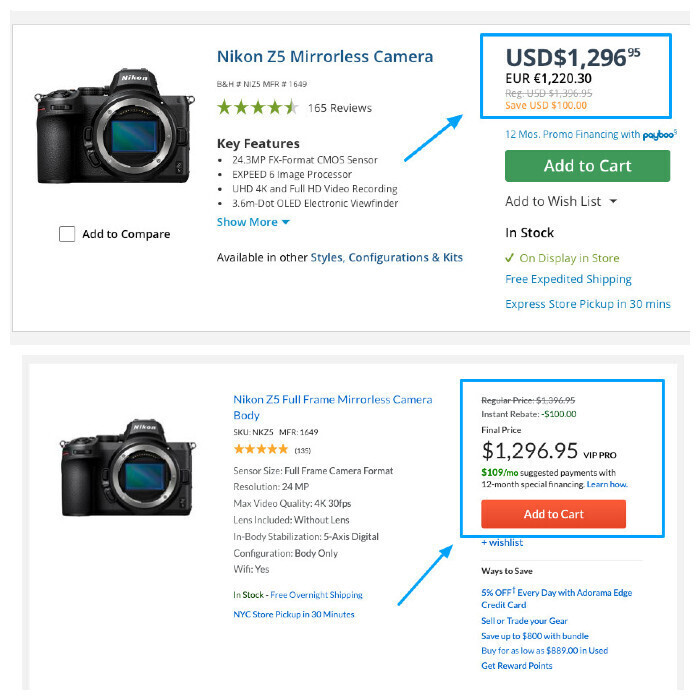
You’ll notice that both prices are identical, down to the cent.
Now, Nikon might control or set the price for retailers selling their cameras, but Adorama and B&H both offer packages, kits, and bundles that allow them to set unique price points.
This also benefits customers who need more than just a camera body to get started on their photography hobby.
When setting the prices for your own ecommerce business, consider packages and other special offers that will set you apart from your competitors.
This is especially important if your margins are tight and you don’t have much wiggle room on the base price of your items.
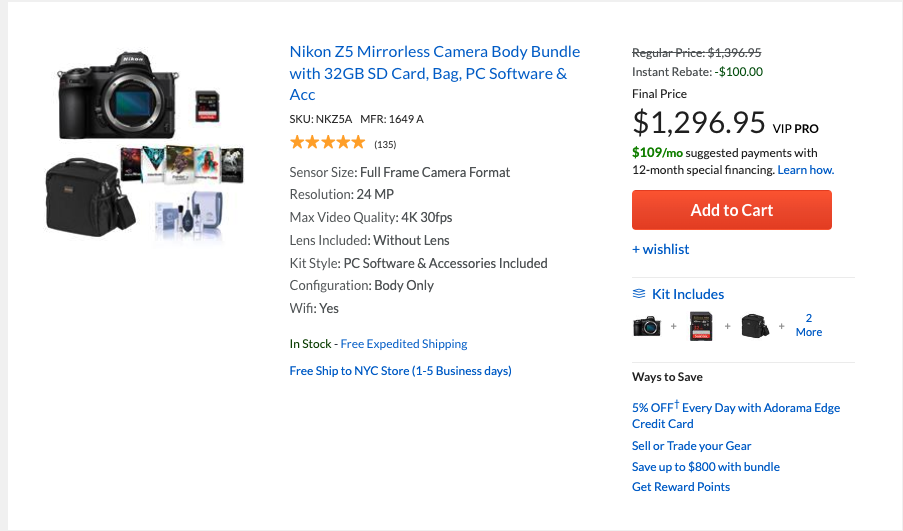
Above, Adorama has created a Nikon Z5 package that includes an SD card, camera bag, and more, at the same price point that just the Nikon Z5 body sells for on other photography sites.
So, take note of any promotional packages, bundles, or other specials your competitors are offering.
Discover Your Market Potential
With Fernando Angulo, Senior Market Research Manager at Semrush
To scale your online business, you need to know what’s in your online market and be aware of other companies, products, or services that may threaten your expectations.
Why do market research?
Brands need real-time information about what’s happening in their industry. And they need to know what position they have in the market, how to expand their share, and what returns they can expect.
Having data from your industry can help you develop an effective marketing strategy (an example from the Market Explorer tool is featured below).

What aspects should be considered during the process?
The depth of your market research is up to you, but you should consider some key concepts such as:
- Digital market share: The place your business occupies compared to the total market
- Level of competition: The ease of competition in a given market is key to estimating the resources needed
- Key players: The number and size of key players helps you know who you’re competing against and create innovative strategies
- Market size: It’s not the same to have a potential market of 1,000 people as it is to have a million; the size of the market is key to defining its potential
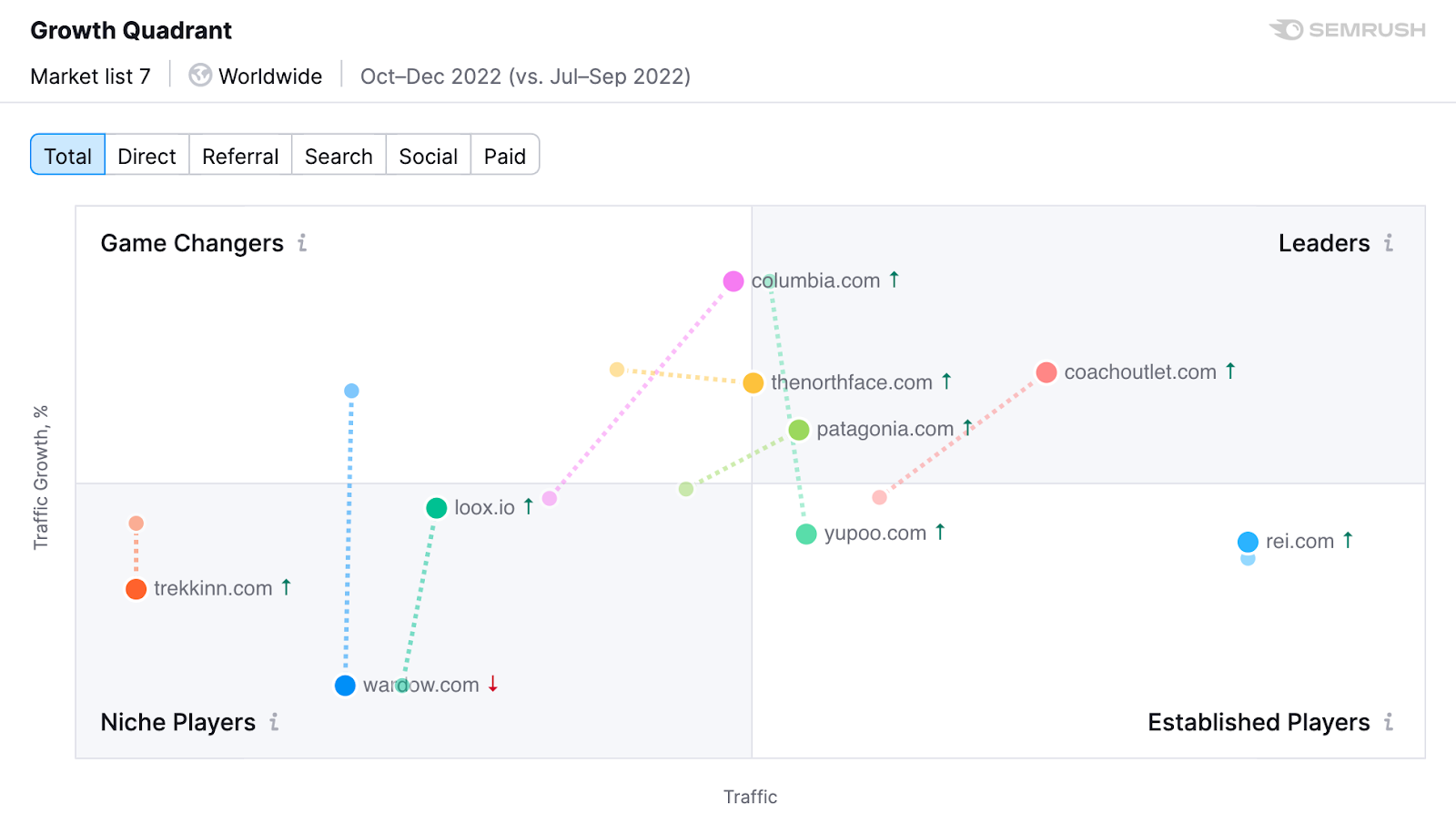
When we focus on the growth of our brand as compared with competitors, such as in the graphic above showing examples of The North Face, Patagonia, and Columbia, we must look at the reasons for such rapid growth and turn to a deeper analysis.
Any tool or strategy designed to analyze large amounts of data in order to produce useful information is simply referred to as an “electronic commerce analysis.” Ecommerce produces complex and complete data sets, particularly those that are related to audience analysis, because it operates in a nearly entirely virtual environment.

Ecommerce competitive research evolves to keep pace with customer experiences and track purchases across all touchpoints: mobile, social, web, and retail store.
Paid and Organic Search Analysis of Competitors
Don’t overlook how your competitors are reaching their customers. What is their share of voice? Where do their ads appear in search, and how many high-value keywords are they ranking for in organic search?
These are all questions you’ll want to ask as you do your analysis. Thankfully, competitor analysis tools can help you do most of the heavy lifting.
For information on a breakdown of how your competitors get their traffic (paid vs. organic), go to the Benchmarking report in the Market Explorer tool.
Tools that can help:
- Traffic Insights for Amazon—A reverse ASIN tool that helps you dissect the promotional strategies of competing products
- .Trends—A competitive intelligence solution that is available with paid Semrush subscriptions (includes Traffic Analytics, Market Explorer, and EyeOn)
- EyeOn—Monitor your competitors’ online sales and marketing strategies 24/7
- Competitor Tracker for Amazon—Automate your competitor research and get crucial data on competitors’ sales, ads, and search rankings
- AdClarity—Unwrap competitors’ digital ads, ad spend, and impressions
- Audience Intelligence—Discover in-depth consumer segmentation and cultural insights
- Klevu—Uncover shopper intent and help get your products discovered
- Commerce Inspector—Free Chrome extension that allows you to track any Shopify store’s product launches, best sellers, traffic, sales, ad campaigns, apps, and more
Maximize Your Traffic Performance
With Dan Saunders, Head of Performance Marketing | International Keynote Speaker & Judge
Adobe recently reported that 55 percent of marketers see data-driven marketing as their most important business opportunity, while 42 percent saw improving customer intelligence as a key priority. If your marketing initiatives are backed by data, you’re likely to see a much higher ROI—and there are a few ways you can use it to drive conversions:
Keep customers moving through their buying journey: Is your data showing traffic flowing to your site but only a few are converting? Using data, you can view a user’s journey through your website including where they came from, how they interacted with your site, and where you lost them—all of which can inform future campaigns. CRO techniques can be used to maximize these conversion opportunities and help reduce barriers to conversion by interpreting data to inform onsite improvements.
Re-engage inactive customers: Many brands believe if they have a great product or service, customer retention will naturally follow. While this may be the case in some instances, it is not an effective long-term strategy. Earning customer loyalty requires an ongoing, consistent effort. Do you have customers that haven’t converted with you in a while? Re-engage them! You’ve already established trust, inspired confidence, and even have data on their previous interactions, making it easier to identify their needs. By re-engaging your customers in a relevant and positive way, you can raise brand awareness and strengthen loyalty.
Identify what’s trending: Data allows you to track real-time changes. If you can interpret the trends of your audience before they even begin, you can apply them to your business to create a competitive edge. Combining data from ads, social media, customer habits and even the economy, informed predictions can be made on what your audience might want next. The ability to forecast upcoming behavior allows you to improve business operations, product developments, future-proof technology, and ensure your marketing strategy is always relevant.
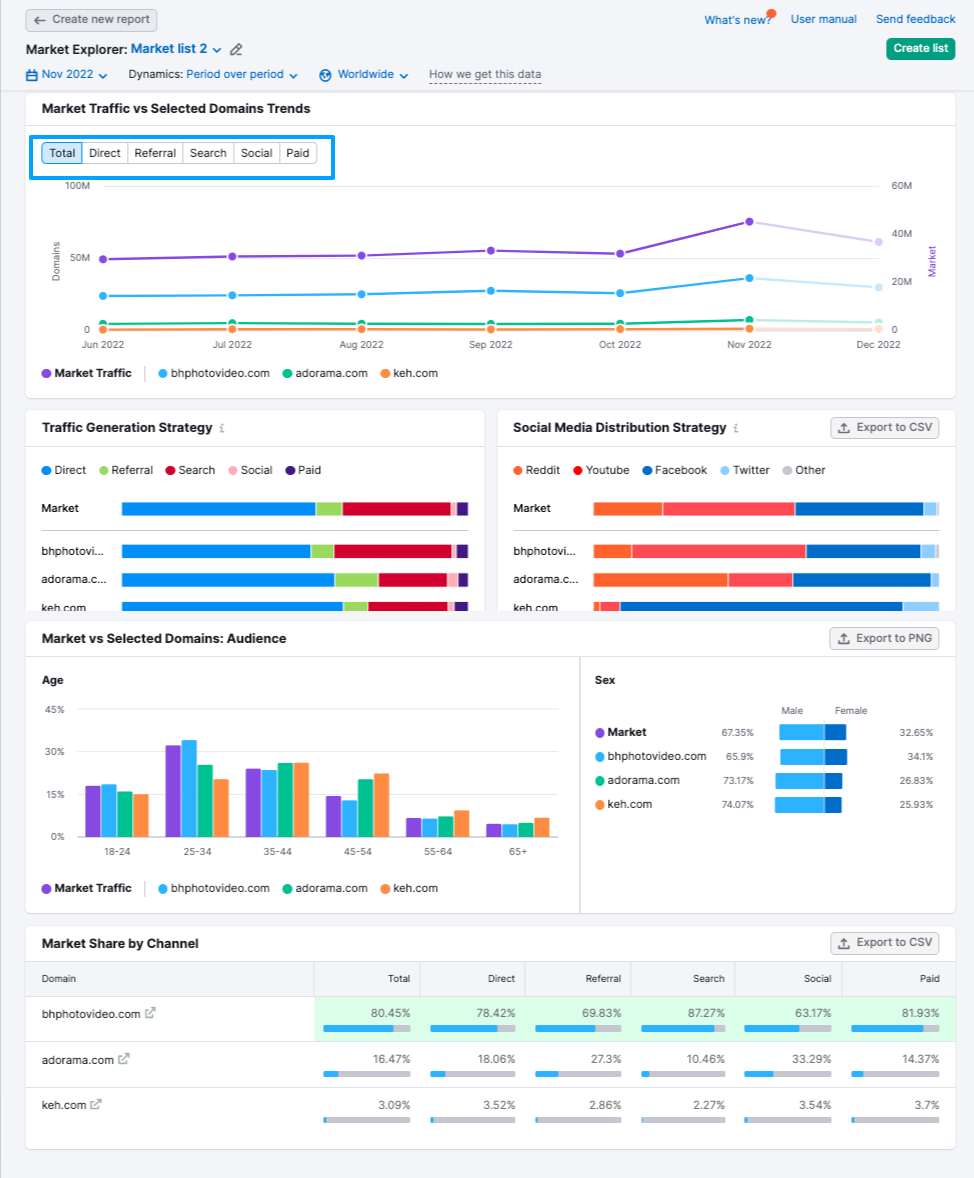
This report from Market Explorer allows you to generate a list of your competitors and see, side-by-side, just how and from where they get their traffic. At the top of the page (see the blue box in this screenshot) you can filter by channel to see their traffic patterns on a more granular level.
Another competitor analysis tool you can leverage is the Advertising Research tool.
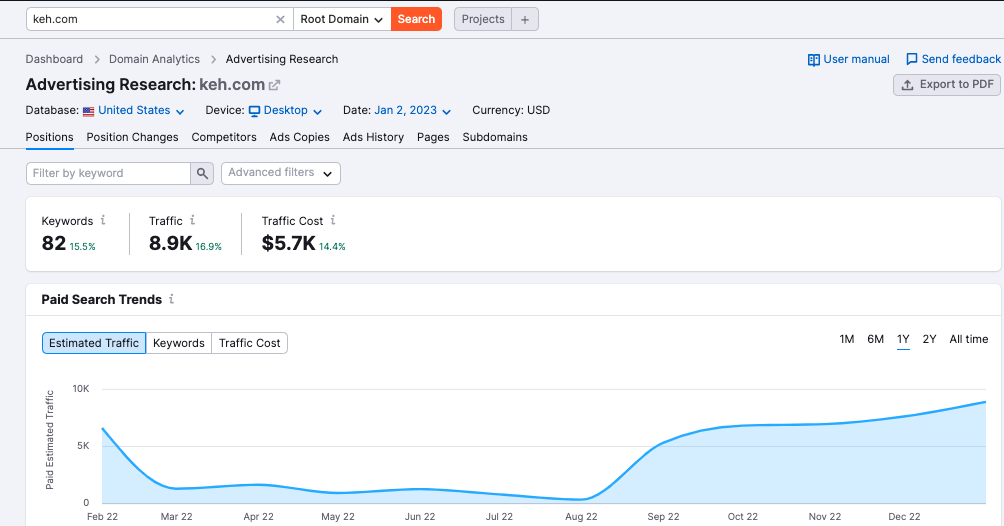
The Advertising Research tool allows you to keep tabs on what Adwords your competitors are bidding on. The tool offers tons of data points and filtering.
For example, you can track Adwords that your competitors have gained and lost over time. Just click on “Position Changes” to get a report detailing their gains and losses.
This is a fantastic way to assess the paid advertising gap in your industry. Maybe you can pick up Adwords that your competitors have lost and gain new traffic.
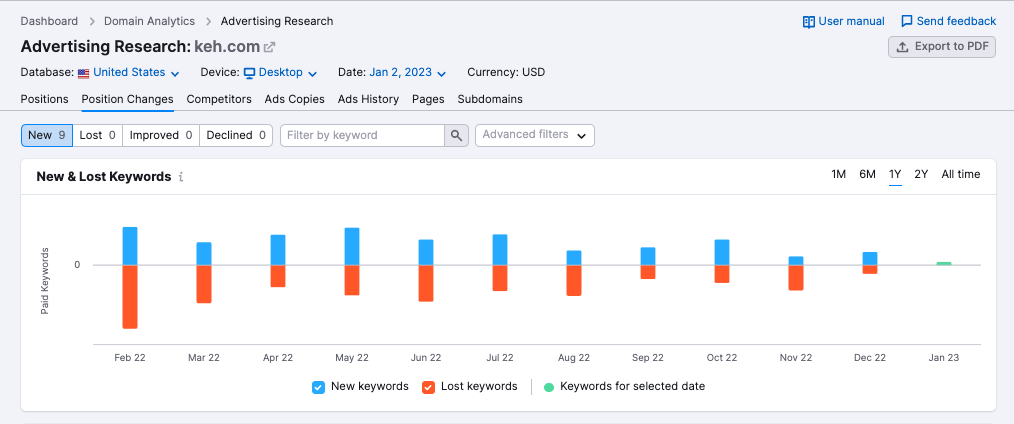
While paid advertising is essential for both you and your competition, search engine optimization (SEO), at both the local level and beyond, can help you get a better ROI on your marketing efforts.
Tools that can help:
- OptiMonk—Create customized pop-ups
- ReConvert—A Shopify upselling app to help you sell more and optimize the customer journey
- PickFu—Run polls to get in-depth feedback from real people in minutes
- Mailchimp—Bolster your traffic wins by reaching customers/searchers through engaging email marketing
- LimeSpot—Leverage your traffic through AI-driven personalization and customized merchandising solutions
- Traffic Insights for Amazon—Uncover external traffic channels for Amazon listings
- Search Insights for Amazon—Analyze search performance on Amazon to gain visibility for your own listings
- Product Feed Health Checker—Help your product rank in Google Shopping
Invest in Your SEO (Content, Technical, Local)
SEO lends itself very well to ecommerce, especially for sites with a larger inventory, because it’s a scalable, low-cost sales channel.
In 2022, Google started to invest heavily in shopping Search and changed the SERP design significantly. Ecommerce webmasters can now impact their product snippets with shipping times, refund policy, and discounts through Google Business—every online store should look at this!
Today, most brand awareness occurs on Instagram, Facebook, or TikTok. As per the study by KPMG, two-thirds of consumers plan to reduce their non-essential spending in 2023. So if a consumer needs to buy non-essential things, they would have more layers of research before spending. In that case, being present on search engines become unavoidable. Repurpose the content you create for social media marketing, put it on the website as a blog and video, optimize the site for a powerful user experience, and be present at local events to build the brand’s authority and visibility. Being seen works far better than being virtual.
Great SEO can help grow your business exponentially. Bad SEO can sink your website to the bottom of the search engine results pages (SERPs). That’s why it is vital to have a multi-prong, careful approach to your website’s SEO.
This is especially important in the world of ecommerce where sites tend to be large and feature tons of product pages and item listings. Keeping your website tidy and user-friendly will help you maintain your current customer base and grow your following.
Not to mention, the global recession is putting huge pressures on paid channels—CAC continues to rise, straining paid advertising budgets and marketing strategies.
Organic SEO not only brings the cost of CAC down, it also works well in partnership with your paid ad strategies.
If you haven’t already begun investing in organic growth, now is the time to get started.
We have a comprehensive guide to SEO for ecommerce here and some handy tips on building an ecommerce content marketing strategy here. But, just to give you a broad-strokes idea of what this investment will entail, here are some tactics that successful ecommerce websites use:
- Eliminate website bloat: Consider building content pillars to consolidate information about groups of products you offer. This helps improve the customer experience. For example, if you sell shoes, you might want to create a pillar page around running shoes and another pillar page around sandals.
- Monitor your desktop and mobile performance: According to Outer Box Design, nearly 80 percent of smartphone users will make a purchase from their mobile device in the next six months. Make sure your website performs just as well on mobile as it does on desktop devices.
- Create unique, compelling, keyword-driven content: This one is a little more nebulous, but as a rule of thumb you want your content to offer something to your customers beyond just a sales pitch. This not only helps you rank better in the search engines but also shows your customers you are an authority in your industry. For example, if you sell cameras, you might want to write articles about how to get started in astrophotography.
- Consider adding schema: This is a big one for ecommerce sites. Schema is a markup language. It exists to help your site stand out in the SERPs. There are different types of schema you can utilize to get traffic to your website. We have a guide that will show you how to start.
- Keep tabs on offline business: Whether or not you run a brick and mortar business in addition to your ecommerce website, you will want to know how your local competitors are appearing in search. If you do have a brick and mortar location, make sure that your local SEO is set up correctly.
This is by no means an exhaustive list—just small pointers to offer you a little SEO inspiration heading into 2023. SEO has a major influence on ecommerce growth, but there is an emerging trend in the world of marketing: influencer and affiliate marketing.
Tools that can help:
- Semrush Local—Rank higher locally by optimizing listings, reviews, maps, etc.
- On Page SEO Checker—Offers a complete and structured list of things you can do to improve the ranking of pages on your website
- Site Audit—Get a holistic view of how your website is performing and monitor tech SEO errors that can hold your site back (especially important for large ecommerce sites)
- Product Feed Health Checker—Get recommendations on optimizing your product’s content, verify that you are employing the most relevant keywords, and create the idea product pages to win in Google Shopping
- Listing Quality Check for Amazon—Audit your Amazon listings and get actionable advice to increase visibility and conversion rates
- SEO Content Template—Generate actionable briefs for SEO-friendly content
- Keyword Magic Tool—Get millions of keyword suggestions for your SEO strategy
Influencer & Affiliate Marketing Are Crucial
Modern consumers tend to choose shopping online: 63% of every purchase begins with online shopping. More than 2 billion people are digital buyers—this means that over 27% of the world’s entire population buy things online. And almost all of them have at least one account on a social media platform, following some influencers there, as there already are more than 4.5 billion social media users on the planet. Sounds like a huge audience to reach!
Consumers trust influencers, their opinions and recommendations. This makes influencers perfect providers for ecommerce brands that wish to win consumers’ hearts and increase sales. BuzzGuru’s global influencer marketing research shows that 92% of consumers trust influencers’ native ads more than traditional advertising. People are more willing to listen to the influencers than brands themselves: the research also shows that 61% of consumers trust influencer recommendations and only 38% trust branded content.
All these make influencers one of the most valuable sources of traffic for brands, including ecommerce ones. Marketing experts admit it. Also, the ROI of influencer marketing is reported to be 11 times greater than that of more traditional types like banner advertisement.
So it’s no surprise that influencer marketing is becoming more and more popular. Ecommerce brands strive to use the most effective marketing channels, and influencer marketing has already proven to be one of those.
Influencer and affiliate marketing has become huge in the last five or so years. If you haven’t delved into this world, it is a sales tactic that employs the use of popular influencers, third-party sites, and other brands to market your products for you.
A great recent example of influencer marketing that led to increased conversions (in this case downloading an app) was the partnership between Dunkin’ Donuts and influencer Charli D’Amelio.
D’Amelio became very popular on TikTok, and when Dunkin’ Donuts realized there could be a lucrative partnership potential, they created the custom Charli iced coffee drink.

This influencer partnership resulted in an over 56% percent increase in downloads of the Dunkin’ Donuts app.
The vast majority of influencer marketing now happens across social media networks like Facebook, Instagram, Twitter, and LinkedIn.
The benefits of influencer/affiliate marketing are numerous:
- Access to an established, new acquisition channel via the brand or individual you choose to partner with
- Potentially cheap advertisement—sometimes affiliate marketing relies on a quid pro quo system where a brand/influencer will write a review in return for free products or advertising their product/service on your social media accounts
- Influencers are typically seen as trustworthy by their followers, so no need to spend a ton of money or time building up organic authority through your website
- A network of affiliate partnerships, which opens your business to an evergreen channel of marketing opportunities
In particular, ecommerce brands can benefit from establishing strong relationships with influencers. Any time you release a new product, you can have a select group of influencers at the ready to test the product and provide an honest review on their social media pages.
If you’re in the market to build some new influencer connections, try an app like BuzzGuru to help you:
- Find influencers on social media looking to connect with business partners
- Make strategic decisions based on influencers’ metrics
- Get reports on an influencer/affiliate campaign’s performance
- Create and deploy campaigns with social media influencers
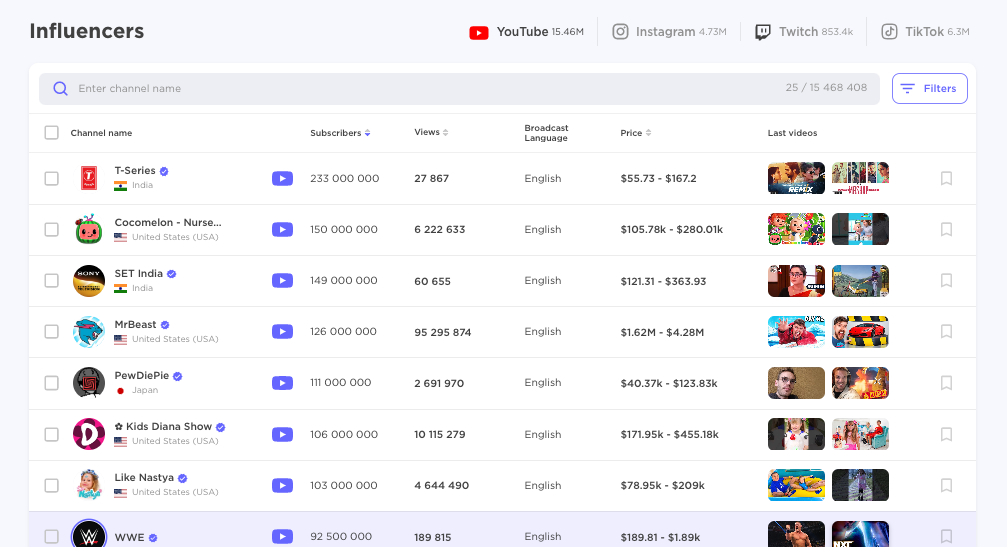
With the BuzzGuru app, you can filter influencers by channel or name to get the most relevant results.
Tools that can help:
- BuzzGuru—Run, monitor, and analyze your influencer marketing campaigns all in one place
- Social Tracker—Lets you track the social media accounts of your closest competitors and compare their growth and engagement levels to yours
- Social Analytics—See your internal analytics metrics for your social media channels
- Captiv8—Find the best content creators to get your message out, execute campaigns, and analyze campaign performance
- ReferralCandy—Reward customers for referrals and grow your sales by word-of-mouth marketing
Prime Day, Prime Early Access & Turkey Five (Thanksgiving-Cyber Monday) will continue to be the most significant ecommerce sales events of the year. Expect more retailers to jump on the bandwagon and run their version of these sales to entice shoppers. Walmart ran ‘Deals for Days Sale’ and Target ran ‘Target’s Deal Days’ in July during Prime Day.
While it would be nice for customers if you could run a sale or big promotion weekly, that’s probably not realistic in 2023. Between supply chain issues, saturated markets, and customers fatigued by gimmicky and aggressive sales tactics, you might not get the response you’re looking for if you advertise a markdown every week.
So, it’s really important to be thoughtful about the timing around seasonal sales and promotions.
Two of the biggest sales events of the year are Amazon Prime Days and Black Friday. These events cover only a few days but can have a massive positive impact on your visibility.
According to Digital Commerce 360, over 300 million items were sold on Amazon during the 2022 Prime Days event.
Consumers broke records on Black Friday 2022, according to Adobe Analytics, by spending an incredible $9.12 billion on online purchases.
It’s a safe bet that these two events will be lucrative in 2023 as well. Prepare by planning out now which items you want to advertise and mark down for these events.
Amazon Pricing Trends
An Amazon Price Study conducted by Semrush came to some very interesting conclusions about what products sold best on/around Black Friday 2022: women’s lingerie and PopSockets for phones. So, you may want to think outside the box about what items you mark down for seasonal promotions.
If you’re selling on Amazon, be sure that your listings are enticing and set up correctly. Semrush has a suite of apps that are designed to help you optimize your Amazon ecommerce business.
Now would be the perfect time to get the Product Research for Amazon app to track buying and listing trends leading up to Prime Days 2023.
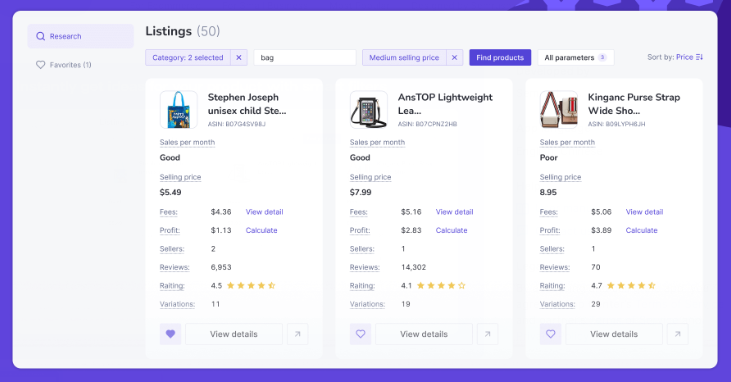
While you should be selective about what types of promotions you run, offering seasonal promotions is prudent, especially if you sell seasonal products.
If you run a bathing suit company, you’ll likely want to start marketing your new line of suits in the winter because customers in cold climates will love nothing more than thinking about lounging by a pool. Consider offering them a promotion on purchasing multiple suits.
At the end of the summer season, you can again offer a discount rate on your suits since people will be focused more on buying coats and cold-weather attire.
REI does a fantastic job timing its promotional sales with seasonal changes and upgraded product offerings hitting the marketplace.
While it almost always has some sort of promotion on its website (or through its co-op program), not every item is discounted.
For example, it is not uncommon for REI to promote and slash prices on running shoes mid-winter, or around the first of the year. That’s because many customers will be making resolutions to get fit or spend more time outside.
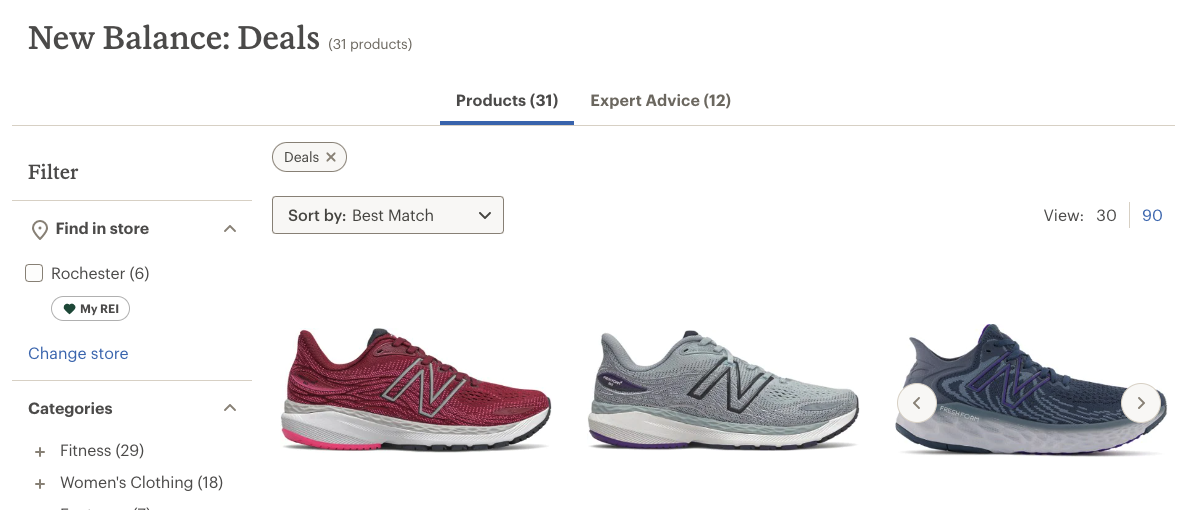
By running these well-timed sales events, REI also signals that they know and understand customers’ wants and needs.
Another way to support your customers through the ecommerce sales process—and by extension, grow your loyal following—is by building a comprehensive resource hub or network to answer customer questions and concerns.
Tools that can help:
- Keepa—Easily track Amazon competitor prices
- Listing Alerts for Amazon—Monitor and secure your business on Amazon
- Competitor Tracker for Amazon—Keep tabs on your Amazon competitors
- Cogsy—Predictable inventory management for Shopify merchants and Amazon sellers
- Privy—Grow your email and SMS lists faster, incentivize new customers, interactive spin-to-wins, and more
- OptiMonk—Generate smart welcome popups, conversational popups, lucky wheel popups, and ebook popups
- ReConvert—Mmake it easier to optimize your post-purchase journey
Build a Responsive Customer Support Network
It is virtually inevitable when running an ecommerce business that you will encounter customer questions or concerns. Even the most conscientious, thoughtful businesses need to be ready to address these comments.
Building or growing a customer support arm of your ecommerce business should absolutely be a top priority in the coming year.
While it is great to have foundational solutions like chat support services, a customer care email address, and in some cases a call center, the competition for best customer service is going to be fierce in 2023.
That’s why some ecommerce businesses have opted to go above and beyond to retain and keep their customers happy.
Take CVS, for example. The large pharmaceutical company also operates an ecommerce site that sells everything from COVID-19 tests to supplements.
Recognizing its own huge product offering and that often these products are in the health and wellness space (which can be confusing to navigate), CVS set up a site full of educational resources.

Without scrolling far, customers can get support with a number of medication and medical-related questions and concerns.
CVS uses its website to provide multiple touch points for customers who might have questions about a prescription, or who maybe had an issue with a delivery and need to talk with someone about it.
CVS also encourages feedback with a dynamic tab that follows you as you scroll down the page.
In other words, CVS makes every effort to make it easy for customers to find what they are looking for and to contact a CVS representative should they encounter a problem.
Another often overlooked aspect of customer relationship management is third-party review sites like Yelp and Google. Customers who cannot easily reach your business might be inclined to vent their frustrations on aggregated review sites like these.
It is important to have a response strategy in place. Don’t let positive or negative comments languish. If a customer takes the time to leave positive feedback, thank them for doing business with you.
If a customer has a complaint, regardless of whether or not it is entirely fair to your business, it’s best to remain cordial, non-argumentative, and offer to speak with them via a more private venue to address the issue.
Doing right by your customers helps you retain them (which is cheaper than building new acquisitions), and it is likely to bring better reviews—the digital era’s version of word-of-mouth referrals.
Don’t wait until you are inundated with bad PR to begin building or improving your customer and online reputation strategy. A great time to start is before you have a problem.
Tools that can help:
- eDesk—An all-in-one help desk for ecommerce businesses; unify queries, orders, and customer info into a single view
- Sendinblue—Leverage live chat capabilities and chatbots to help customers solve problems quickly
- Gorgias—An ecommerce help desk that centralizes all support tickets into one convenient place
- Zendesk—A SaaS that helps you streamline your customer support process and handle tickets more efficiently
Make 2023 the Best Year Yet for Your Ecommerce Business
There are many reasons to be excited about the future of ecommerce business in 2023. Hopefully this article has illustrated that you as a marketer or business owner have virtually endless tools, tactics, and strategies at your disposal to make this your most successful year of business yet.
Ready to start the year off right? Get free trial access to our suite of Solutions for Ecommerce businesses. Save yourself time and guesswork by letting Semrush’s data-driven apps help you develop a winning strategy that works for your business.
